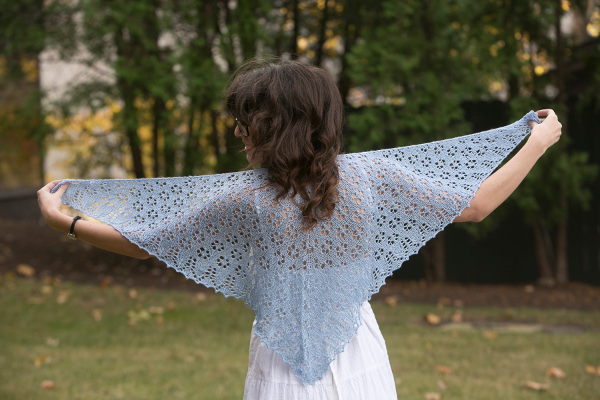
Sometimes all you need is a simple lace pattern and a lovely yarn that’s easy on the eyes and the hands. The alpaca bamboo blend yarn is ridiculously soft with a subtle sheen from the bamboo. This simple charted shawl is excellent for lace beginners. This shawl can easily be made larger by working more repeats of the Body Chart.
Skill Level: Easy
Size: 52″ wide and 22″ deep
Gauge: 18 sts and 24 rows = 4″ in St st in stockinette after blocking
Materials
Yarn: The Alpaca Yarn Company Mariquita (50% alpaca, 50% tencel; 437 yards [400 meters]/100 grams): #4020 Blue (1 skein)
Needles: US size 6 (5.0 mm) long circular needles
Abbreviations
Cdd: Center double decrease
Sl1yif: Slip 1 with yarn in front
Kyok: Knit 1, yarnover, knit 1 in same stitch
K1tbl: Knit 1 through back loop
K2tog: Knit 2 together
Ssk: Slip slip knit
Pattern Notes
This triangular shawl is worked top-down with 6 increases per wrong-side row to achieve a shallow triangular shape.
Pattern
Set-Up Chart
Cast on 9 sts.
Row 1: Sl1yif, kyok, k2, kyok, k2, kyok, k1tbl.
Row 2: Purl
Row 3: Sl1yif, kyok, k5, kyok, k5, kyok, k1tbl.
Body Chart
Row 1: Sl1yif, [kyok, k8] twice, kyok, k1tbl.
Row 2 and all EVEN rows: Purl all stitches.
Row 3: Sl1yif, kyok, k2, yo, cdd, yo, k6, kyok, k6, yo, cdd, yo, k2, kyok, k1tbl.
Row 5: Sl1yif, kyok, k2, ssk, yo, k3, yo, k2tog, k1, ssk, yo, k2, kyok, k2, yo, k2tog, k1, ssk, yo, k3, yo, k2tog, k2, kyok, k1tbl.
Row 7: Sl1yif, kyok, k6, yo, cdd, yo, k5, yo, cdd, yo, kyok, yo, cdd, yo, k5, yo, cdd, yo, k6, kyok, k1tbl.
Row 9: Sl1yif, kyok, k12, kyok, k12, kyok, k1tbl.
Row 11: Sl1yif, kyok, k6, yo, cdd, yo, k5, yo, cdd, yo, kyok, yo, cdd, yo, k5, yo, cdd, yo, k6, kyok, k1tbl.
Row 13: Sl1yif, kyok, k3, yo, k2tog, k1, ssk, yo, k2, kyok, k2, yo, k2tog, k1, ssk, yo, k3, kyok, k1tbl.
Row 15: Sl1yif, kyok, k2, yo, cdd, yo, k5, yo, cdd, yo, kyok, yo, cdd, yo, k5, yo, cdd, yo, k2, kyok, k1tbl.
Work the Body Chart 5 times. (261 sts)
Edging Chart
Row 1: Sl1yif, kyok, k16, kyok, k16, kyok, k1tbl.
Row 2 and all EVEN rows: Purl all stitches.
Row 3: Sl1yif, kyok, k1, k2tog, yo, k1, yo, ssk, k3, k2tog, yo, kyok, yo, ssk, k3, k2tog, yo, k1, yo, ssk, k1, kyok, k1tbl.
Row 5: Sl1yif, kyok, k3, k2tog, yo, k1, yo, ssk, k3, k2tog, yo, k1, kyok, k1, yo, ssk, k3, k2tog, yo, k1, yo, ssk, k3, kyok, k1tbl.
Row 7: Sl1yif, kyok, yo, ssk, k3, k2tog, yo, k1, yo, ssk, k3, k2tog, yo, k1, yo, k1, kyok, k1, yo, k1, yo, ssk, k3, k2tog, yo, k1, yo, ssk, k3, k2tog, yo, kyok, k1tbl.
Row 9: Sl1yif, kyok, [k1, yo] twice, k2, cdd, k2, yo, k1, yo, k3, kyok, k3, yo, k1, yo, k2, cdd, k2, [yo, k1] twice, kyok, k1tbl.
Row 11: Sl1yif, kyok, k2tog, k1, yo, k3, yo, k1, cdd, k1, yo,, k3, yo, k1, ssk, k1, kyok, k1, k2tog, k1, yo, k3, yo, k1, cdd, k1, yo, k3, yo, k1, ssk, kyok, k1tbl.
Row 13: Sl1yif, kyok, k1, yo, cdd, yo, k5, yo, cdd, yo, k1, kyok, k1, yo, cdd, yo, k5, yo, cdd, yo, k1, kyok, k1tbl.
Work the edging chart once – 307 sts, and then work the picot bind-off as follows: BO3, *cable cast-on 2 sts, BO6; repeat from *.
Finishing
Block using desired method to open up the lace pattern and bring out the points on the picot edging. The top edge of the shawl will have a natural curve to it.


What is a double decrease?
Hi Barbara,
A double decrease is worked by doing the following: slip 2 as if to knit, K next stitch, PSSO the K stitch.
Thank you!
Julia Wiatr, editor